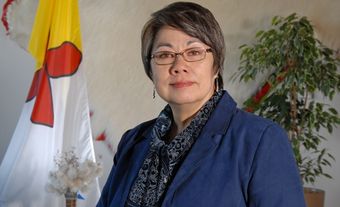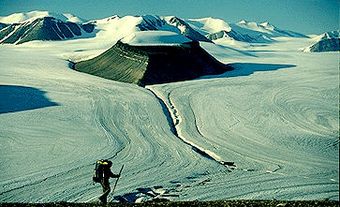
Early Life and Education
Okpik was born in the Mackenzie Delta area of the Northwest Territories, near Aklavik on 12 January 1929. His namesake, Auktalik, was one of the last of the angakkuit (shamans) with a special power to heal. While Okpik was brought up in the Anglican Church, he was also raised traditionally. Okpik hunted and trapped, travelled by dog sled and built igluit.
In 1937, when Okpik was eight years old, he was sent to a residential school. Okpik initially encountered difficulties adjusting because this was his first time attending school and he did not know English, the language of instruction. Despite these struggles, Okpik proved to be a gifted student. He became an avid reader, learned English and skipped grades two, four and five. In the spring of 1941, Okpik’s father removed him from school so that he could assist his family with trapping.
After he left school, Okpik made his living as a hunter. In 1942, while running his dog team and bringing home caribou meat for the winter, Okpik suffered a leg injury that left him permanently disabled. Despite his injuries, Okpik continued to hunt and trap.
In the 1950s, he and his brothers-in-law also helped to build the Distant Early Warning (DEW) Line, a system of radar stations in Canada’s Arctic used to defend North America from enemy attacks during the Cold War. While the construction and operating of the DEW line provided some economic development for the Arctic region, it also had long-lasting, damaging effects on Inuit subsistence economies and the environment. Canadian government clean-up efforts, aided by Inuit, were completed in March 2014.
In 1945, Okpik was diagnosed with tuberculosis in his bone and spent three years recovering in hospital. He tested positive a second time for tuberculosis in 1957, and recuperated in hospital in Aklavik, Northwest Territories, for 18 months.
Political Career
In 1959, Okpik started working for the Diefenbaker government as a translator. During this time, Okpik learned the syllabics writing system used in the Eastern Arctic. He also translated books from English to Inuktitut, which became some of the first publications in the Inuit language.
By the 1960s, Okpik was living in the community of Frobisher Bay (present day Iqaluit), where he worked as the director of the Rehabilitation Centre at Apex. This structure housed patients recuperating from illnesses and injuries. The centre also functioned as a community hall; it was a place where people socialized and where Inuit labourers sought temporary shelter.
In 1965, Okpik served as an administrator for the Department of Indian Affairs and Northern Development (now Indigenous and Northern Development Canada). He was also appointed to the Northwest Territories Council (now Legislative Assembly of the Northwest Territories) in October of that year. Okpik became the first Inuk to sit on the Council. His role was to serve as a representative for the Inuit in the Eastern Arctic, a population Okpik argued lacked political representation. As a result of his efforts, in July 1966, electoral boundary officers from the federal government divided the North into three separate districts, each to have their own representative. During his time working for the territorial government, Okpik also served as a translator and advisor for other elected members of the Council.
While Okpik helped to organize and administer various government programs in the Arctic during the 1960s, he is best known for his involvement in Project Surname — the Council-led initiative to register Canadian Inuit under last names.
Project Surname
Since the 1940s, the federal government had used disc numbers to identify Inuit populations. These disc numbers carried information about the personal identity and residence of Inuit. In the mid-1960s, the Northwest Territories Council decided to replace these numbers with last names. This undertaking became known as Project Surname. Although surnames are not a part of Inuit naming cultures, the government decided that registering Inuit under surnames was more effective and humane than disc numbers. The Council chose Okpik to lead the project.
From 1970 to 1971, Okpik traveled to various communities in the Northwest Territories, Nunavut and Nunavik in northern Québec. His knowledge of English and various Inuktitut dialects helped him to communicate with different Arctic communities. At each place he visited, Okpik explained the purpose of Project Surname to locals and recorded their surname of choice. He also worked with a linguist and tried to use standardized spellings as much as possible. Some Inuit critiqued Okpik’s efforts, claiming that he spoke mainly to men and allowed relatives to choose a surname for family members who were not present during the naming process. Despite initial discontent with Project Surname, there have been no major efforts since the project began to remove surnames.
Inuit Language
After the completion of Project Surname in 1971, Okpik and his family moved to the Eastern Arctic. There, he became the administrator of a school, the Ukiivik Residence. He also began teaching Inuktitut at the high-school level. Focusing on promoting the Inuit language, Okpik worked with the Inuit Cultural Institute (ICI) to create a new and simplified Inuktitut writing system with 45 letters. Though there was some resistance to this change, the ICI adopted this form of the syllabary in 1974. It is still used today.
Berger Commission
In 1974, Okpik served as an interpreter for Judge Thomas Berger during the Mackenzie Valley Pipeline Inquiry. In the following year, the Canadian Broadcasting Corporation (CBC) hired Okpik as one of five linguistic representatives to report on the Mackenzie Valley Pipeline hearings and on the events surrounding the construction of the pipeline.
At times, Okpik found it challenging to describe the scale and scope of the project to the Inuit population. Trying to explain trillions of cubic feet of gas, for example, was difficult. Okpik explained: “When you talk about trillions, imagine six sand hill cranes and maybe six caribou, and try to count all the feathers and the hair on their body if you have time! You will never get near. A trillion is so huge!” Okpik tried his best to communicate to the Inuit the details about the pipeline project, including the money involved in its construction.
In April 1977, the commission issued its report, which concluded that a pipeline from the Mackenzie Delta down the Mackenzie Valley to Alberta was feasible. However, it also recommended a 10-year moratorium as a means of further studying and settling Aboriginal land claims. In the end, the pipeline was put on hold.
Later Life and Death
In 1979, Okpik returned to Iqaluit, where he spent the rest of his life. There, he also served as an elected member of the town council, and as a volunteer on various organisations and committees. Okpik died in Iqaluit on 10 July 1997.
Awards and Honours
Okpik was made a Member of the Order of Canada on 15 December 1976 for his work with the Berger Commission and Project Surname.
The Abe Okpik Hall in Apex, Iqaluit, was also named for him.
Significance
Abe Okpik was best known for his work on the Berger Commission and Project Surname. While he played important roles in both of these projects, Okpik also made significant contributions to Inuit languages and Northern communities. Whether working for the federal government, the territorial council or local organizations, Okpik sought to protect and promote Inuit culture.

 Share on Facebook
Share on Facebook Share on X
Share on X Share by Email
Share by Email Share on Google Classroom
Share on Google Classroom


